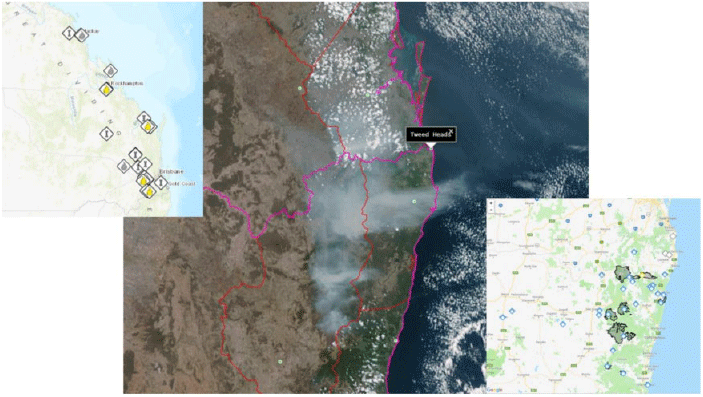The changing role of operational meteorologists
Jenny Sturrock A B and Deryn Griffiths AA Australian Bureau of Meteorology, GPO Box 1289, Melbourne, Vic 3001, Australia.
B Corresponding author. Email: jenny.sturrock@bom.gov.au
Journal of Southern Hemisphere Earth Systems Science 70(1) 114-119 https://doi.org/10.1071/ES19045
Submitted: 28 May 2020 Accepted: 1 July 2020 Published: 17 September 2020
Journal Compilation © BoM 2020 Open Access CC BY-NC-ND
Abstract
The Bureau of Meteorology is changing the way forecasts are produced, from a labour-intensive approach to a more streamlined approach. We describe the essence of the new forecast process using a case study to demonstrate a situation in which meteorologists use their professional judgement to modify what would otherwise be a largely automated forecast service.
Keywords: automated forecast, automation, FirstCut, forecast guidance, forecast production, forecaster’s role, forecasting, GFE, graphical forecasts, grid, grid edits, model blend, OCF, value-add.
1 Background
Since 2008, operational meteorologists at the Bureau of Meteorology (BOM) have used a software package called the Graphical Forecast Editor (GFE) to generate graphical and text-based forecasts and warnings across Australia. The GFE allows forecasters to blend and edit data fields (such as wind, temperature, dew point, cloud cover and rainfall) from numerical models, or other gridded guidance, using graphical tools to produce weather forecasts for the following seven days.
Guidance available to forecasters within GFE includes direct numerical model output such as ACCESS-G (BOM 2012b) interpolated to the scale of the GFE grid, and Operational Consensus Forecast (OCF) guidance, which is a bias-corrected blend of many different numerical models. The OCF algorithm is described in BOM (2012a, 2014), and has had further improvements since then.
Meteorologists have responsibility for one of seven regions, largely aligned with state borders. They use their professional judgement to select the best starting point in terms of numerical model data fields or other guidance, and then edit those fields to construct a forecast that accurately depicts the expected weather. Tools within GFE range from ones that conduct simple linear adjustments over an area and time period, to more sophisticated tools that include algorithms that account for aspects such as elevation, distance from coast, whether wind is upslope or downslope, onshore or offshore and so on. Once the forecast is captured in a gridded format, the GFE generates text forecasts based on the grids. There is an opportunity for meteorologists to review and edit the text forecasts before they are issued. Both the gridded and text forecasts are made available to the public. See Leeuwenburg (2009) for a further description of GFE and Fig. 1 for an example of the GFE interface.
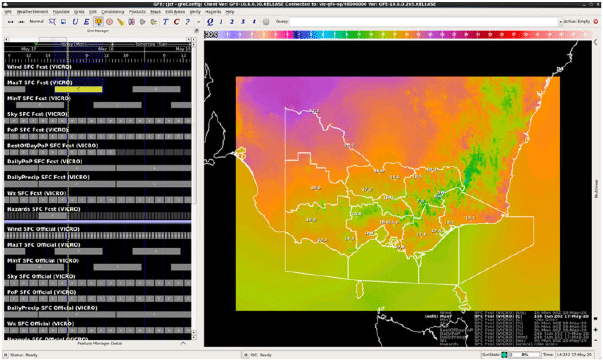
|
There were issues with this approach, including border consistency. In extreme cases, forecast rainfall, storms or fog would end abruptly at state boundaries. Fig. 2 shows an example with good consistency between New South Wales and Queensland, but a clear discontinuity where the Queensland and the Northern Territory areas of responsibility meet.
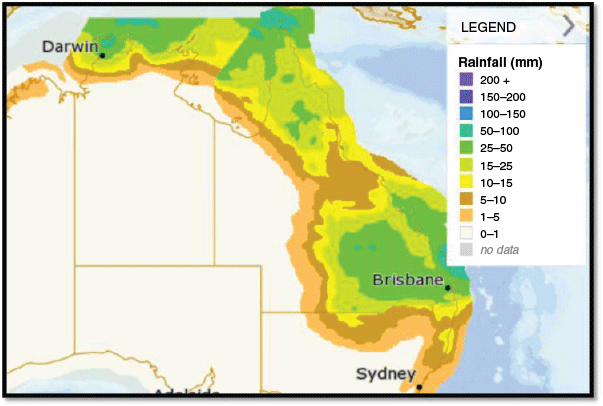
|
Other concerns included a lack of control of the automatically generated text forecast. Sometimes meteorologists spent time editing grids to capture their forecasts but the resulting automatically-generated text would not communicate the key aspects of the situation. Other times, they would edit the grids specifically to obtain desired text forecasts and in doing so publish a gridded forecast that was less than ideal. Extra work was also created by the need to run several GFE tools to ensure weather elements maintained consistency after editing (for example, ensuring that dew point temperatures did not exceed temperature, or that wave heights were consistent with forecast wind strengths).
Over time questions began to arise: was the Bureau of Meteorology seeing a sufficient return on investment? That is, was forecaster time spent editing grids resulting in enough improved accuracy to justify their work? In 2019 a new approach was developed: the Optimised Forecast Process. The process was designed to achieve a delicate balance between relying on automated output as much as possible while maintaining a high standard of accuracy and producing final products that are fit for purpose, including suiting customers who use them to base decisions on, and suiting meteorologists using them as a tool to communicate potential impacts. The Optimised Forecast Process is predicated on the high standard of much of the guidance available, including its improved performance over recent years. It acknowledges situations in which human-added value is important to improve the accuracy of the products and ensure they communicate key messages.
The change to operations with the implementation of the Optimised Forecast Process is not a standalone change, but part of a broader restructure and refocus of the Bureau of Meteorology, which they refer to as the Public Services Transformation.
2 The Optimised Forecast Process
The Optimised Forecast Process was developed and implemented during 2019 (BOM n.d.). It is backed by verification and focuses on freeing up forecaster time enabling them to undertake other high impact activities. The process includes the use of FirstCut Forecast guidance, described below, and stipulates that GFE grids are only edited by forecasters when certain criteria are met. The grid edits are referred to as interventions. The criteria for making interventions are discussed in more detail below. However, essentially the process takes into account the lead-time and outcome confidence of the event, and assesses the value intervention would have as measured by improvement to community safety and prosperity.
FirstCut Forecast guidance relies heavily on OCF data where possible, including for wind, temperature, dew point and precipitation. It includes modifications of OCF shown to improve accuracy such as increasing wind speeds around alpine topography, and modifications to ensure consistency between elements. FirstCut Forecast guidance also includes automated running of some GFE tools to populate grids where necessary, such as the ‘Weather’ grid with categorical elements such as ‘Isolated Showers’ or ‘Patchy Frost’.
To begin, the forecaster loads the FirstCut Forecast guidance then runs through the intervention rules to determine whether to change the gridded forecasts before publishing them. As implemented in 2019, the Optimised Forecast Process is applied to grids populating the time scale of three days or more in advance. The forecasts for today, tomorrow and the next day currently remain subject to professional oversight and judgement.
The rules for intervention as stipulated in the Optimised Forecast Process take into account the synoptic situation and weather elements of interest and rate how valuable an intervention is to the quality of the output and service. The Optimised Forecast Process considers the value of the intervention according to customer impact and the confidence in the forecast. After assessment the forecaster arrives at a result of no intervention, intervention recommended, or intervention required. The matrix summarising how the assessment is made is shown in Fig. 3.
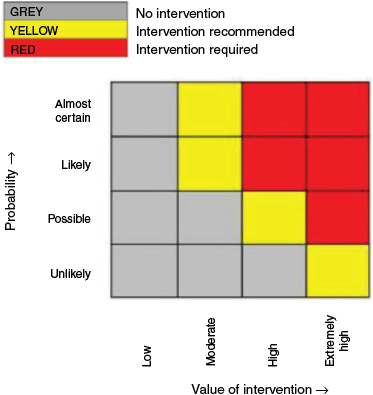
|
No intervention means an assessment has determined that altering the grid would have ‘no effect on forecast/warning service outcome’. Intervention recommended is for situations where an intervention would have a ‘demonstrable effect on forecast/warning service outcome’. Intervention is required when an intervention is expected to have a ‘critical effect on forecast/warning service outcome’.
Consider an event expected in 6 days’ time where there is only low confidence in the forecast and any one scenario modelled for this weather event is considered ‘Unlikely’. Intervention would only be recommended if it was judged as adding ‘Extremely High’ value. For example, if there was a developing Tropical Cyclone, or even the possibility of one, then professional judgement would be used to ensure the grids and text forecasts are consistent with the desired messaging around such a significant event.
When an event is forecast to occur in three days’ time with a good degree of certainty regarding the general situation, then intervention may be recommended for events such as capturing areas where severe thunderstorms are expected, or detail around an expected significant wind change.
3 Case study
We illustrate the Optimised Forecast Process by describing how it was applied to a particular event.
Hot, dry conditions ahead of an unstable wind change meant resultant fire activity on 8 and 9 October 2019 were fire flare up days in northeast New South Wales and southeast Queensland, as illustrated in Fig. 4.
Consider the position of the operational meteorologists on 8 October. They would have had a busy shift, monitoring and issuing forecasts and warnings for fires that day and the next. In addition, they would have been assessing the weather situation for the period 10 to 15 October and comparing their expectation to the FirstCut Forecast guidance.
They would have noted a signal of precipitation expected over the bushfire affected areas in northeast New South Wales and southeast Queensland on 11 and 12 October. The models suggested 10–20 mm as illustrated in Fig. 5, though note that the values in Fig 5 are for a 6-hour period rather than the full 2-day period. The occurrence of widespread rainfall over the fire affected area would have an important dampening effect on the fires. The region had experienced three very dry and warm years (BOM 2019a, 2019b). Some October maximum temperature records had already been broken (BOM 2019d) and the preceding month had mean maximum temperatures in the top decile (BOM 2019c). Fire danger indices in September were very much above average as shown in Fig. 6.
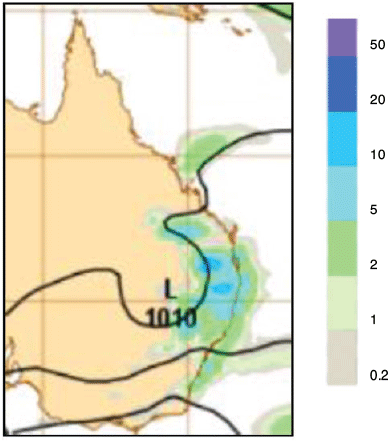
|
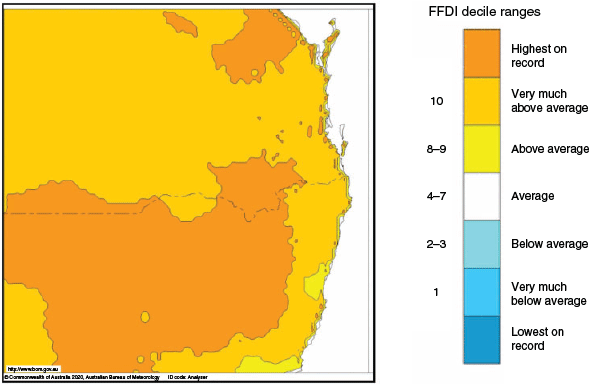
|
However, rather than widespread rainfall, the forecasters in New South Wales and Queensland determined that the precipitation would result from thunderstorms. The rainfall was likely to be highly spatially variable, with some sites receiving less than 1 mm and others well over 20 mm. The distinction in precipitation type would have been important for emergency services, keen to know the extent to which forecast rainfall might contribute to extinguishing the ongoing fires. Furthermore, emergency services needed to know that severe wind gusts, causing damage and driving erratic and dangerous fire behaviour, and lightning, with the potential to start new fires, were likely.
In addition to the interest from the fire agencies, there was substantial community and media interest in the weather and particularly in the potential for rain during the forecast period.
On the whole, operational meteorologists in New South Wales and Queensland decided they were happy with OCF guidance from the FirstCut Forecast process regarding the likelihood of rain. However, they decided to intervene in the thunderstorm forecasts to ensure that the messaging balanced the possibility of rainfall with information about it resulting from gusty thunderstorms. Their decision was in line with the Optimised Forecast Process.
The forecasters assessed that intervention was recommended or required. Using the matrix shown in Fig. 3, they had high confidence in the expected situation (that is, probability of Likely), and assessed the value as High to Very High because intervention would ensure that the graphical and text forecasts aligned with key messaging to the general public, the fire agencies and other emergency services. In comparison had the expected thunderstorms been expected over an area not affected by bushfires or drought, the intervention value would have been assessed as Low to Moderate and no intervention would have been pursued.
In Queensland the interventions to the 3–4 day forecast included some modifications of the Chance of Rain, but the main focus of the intervention was on capturing the areas of thunderstorms appropriately within the gridded forecast. In New South Wales the main focus of the intervention was regarding the description of the thunderstorms.
Widespread thunderstorm activity was observed over the two days with many rainfall totals around 10 mm and isolated heavier falls of up to 50 mm. The forecast, as captured by the GFE grids following intervention, was well aligned with messaging provided by other means such as social media, radio interviews and briefings to the fire agencies.
4 The future
Meteorologist are continually adapting to new forms of data, and new means of communicating forecasts. They understand that their role will continue to change. For example, there are plans to issue forecasts of the Probability of Thunderstorms. As the guidance to support forecasts of Probability of Thunderstorms improves, the need for an intervention regarding thunderstorms forecasts, such as that described in the case study above, will reduce. There is work underway to allow the GFE to be used to edit grids that cover the national domain. Working on a national scale will allow meteorologists to edit grids for weather events near state borders without being constrained by those borders, increasing the efficiency of grid editing.
As forecast interventions become less frequent, meteorologists will be able to use their time in other ways to continue to ensure the community receives impact and value from weather forecasts and warnings. The Public Services Transformation is the vehicle enabling and directing these changes. Some meteorologists will design new products to allow improved communication of any given weather forecast including the uncertainty of the forecast and the range of possibilities. Others will assist to improve OCF, or its successor, ensuring its continued improvement.
The Bureau of Meteorology has assessed that it is still important that meteorologists direct their time towards examining the forecast and using their professional judgement when necessary. Although grid intervention is expected to decrease in frequency, meteorologists will always need time to understand the forecast if they are going to assist customers with key messages, or key points relevant to their specific business. As the duties of operational meteorologists evolve it is essential that this ‘traditional’ forecasting task is retained.
5 Conclusion
We have described why the Bureau of Meteorology is changing the way forecasts are produced, from a labour intensive approach to a more streamlined approach, relying on automation for many tasks much of the time. We have described the essence of the Optimised Forecast Process using a case study to demonstrate the role meteorologists continue to play.
We have provided a snap-shot of a rapidly evolving profession. The forecast process will continue to evolve as the Bureau of Meteorology strives to provide a coherent, consistent and valuable weather forecast service that combines automation and professional judgement in a way that maintains the accuracy of its forecasts and warnings.
Conflicts of interests
The authors declare that they have no conflicts of interest.
Acknowledgements
The first author, Jenny Sturrock, would like to thank the organising committee of the 2019 Bureau of Meteorology Research and Development Workshop for the invitation to present at the workshop. The content of that presentation formed the basis of this paper. Thank you to Tamika Tihema and Robert Fawcett for providing Fig. 6. Thank you to Stewart Allen, Simon Louis and Michael Foley for internal reviews of this manuscript prior to publishing. Thank you to the anonymous reviewers whose comments encouraged and assisted the revision of this manuscript. This research did not receive any specific funding.
References
Bureau of Meteorology (BOM) (n.d.). National Standard Operating Procedures for the Graphical Forecast Editor. Unpublished internal document. Bureau of Meteorology.Bureau of Meteorology (BOM) (2012a). Operations Bulletin Number 91: Operational Upgrades to the Gridded OCF and PME systems. Available at: http://www.bom.gov.au/australia/charts/bulletins/apob91.pdf [Verified 16 May 2020].
Bureau of Meteorology (BOM) (2012b). Operations Bulletin Number 93: APS1 upgrade of the ACCESS-G Numerical Weather Prediction system. Available at: http://www.bom.gov.au/australia/charts/bulletins/apob93.pdf [Verified 16 May 2020].
Bureau of Meteorology (BOM) (2014). Operations Bulletin Number 102 Upgrades to the Operational PME System. Available at: http://www.bom.gov.au/australia/charts/bulletins/apob102.pdf [Verified 16 May 2020].
Bureau of Meteorology (BOM) (2019a). Special Climate Statement 70 update – drought conditions in Australia and impact on water resources in the Murray–Darling Basin. Available at: http://www.bom.gov.au/climate/current/statements/scs70.pdf [Verified 17 May 2020].
Bureau of Meteorology (BOM) (2019b). Special Climate Statement 71 – severe fire weather conditions in southeast Queensland and northeast New South Wales in September 2019. Available at: http://www.bom.gov.au/climate/current/statements/scs71.pdf [Verified 17 May 2020].
Bureau of Meteorology (BOM) (2019c). Monthly Weather Review Australia September 2019. Available at: http://www.bom.gov.au/climate/mwr/aus/mwr-aus-201909.pdf [Verified 18 May 2020].
Bureau of Meteorology (BOM) (2019d). Monthly Weather Review Australia October 2019. Available at: http://www.bom.gov.au/climate/mwr/aus/mwr-aus-201910.pdf [Verified 17 May 2020].
Leeuwenburg, T. (2009). Introducing the Natural Language Generation of Text Weather Forecasts in the GFE. CAWCR Research Letters. Issue 2. (Eds P. A. Sandery, T. Leeuwenburg, G. Wang, A. J. Hollis) pp. 24–29. Available at: https://www.cawcr.gov.au/researchletters/CAWCR_Research_Letters_2.pdf [Verified 16 May 2020].

